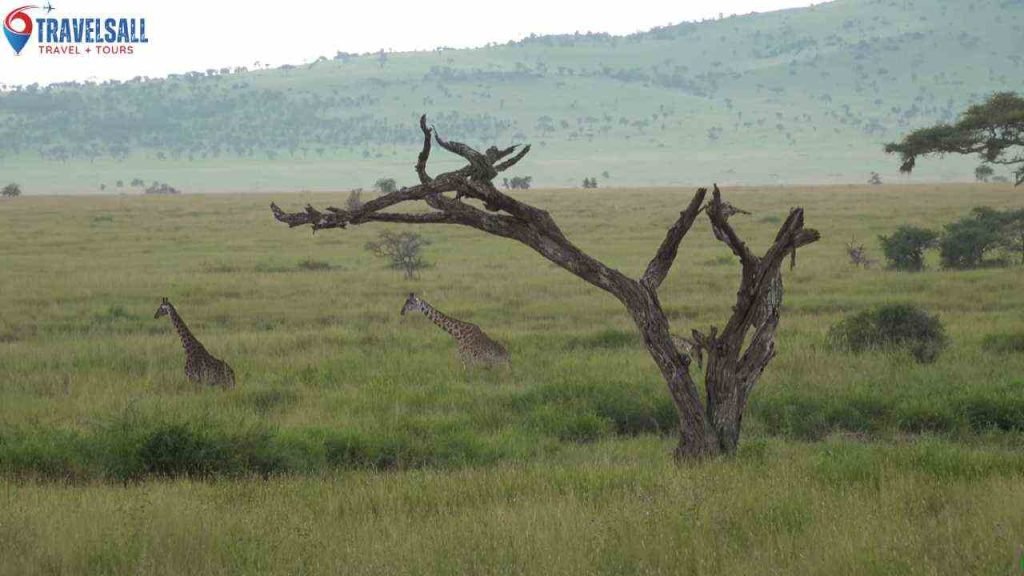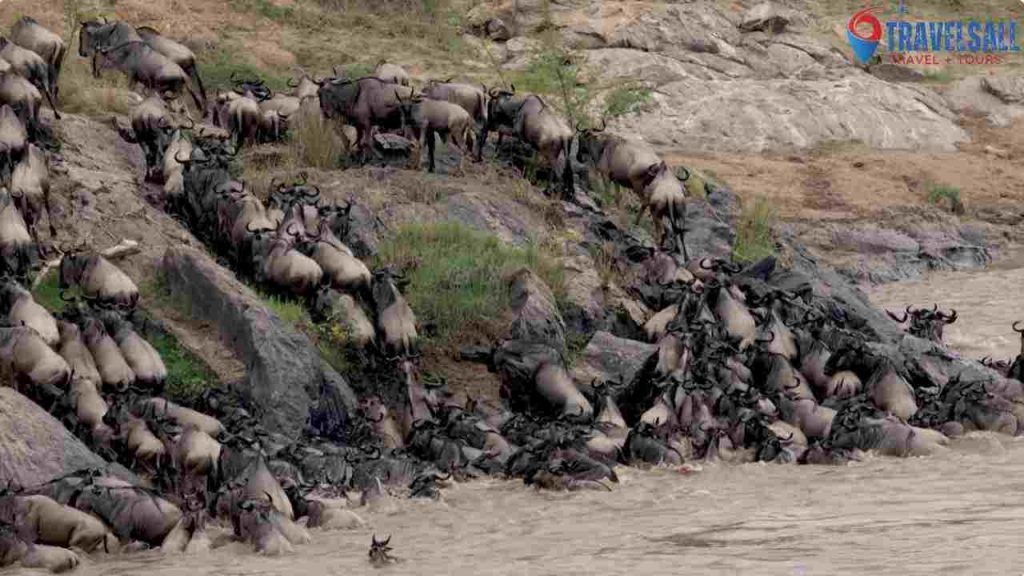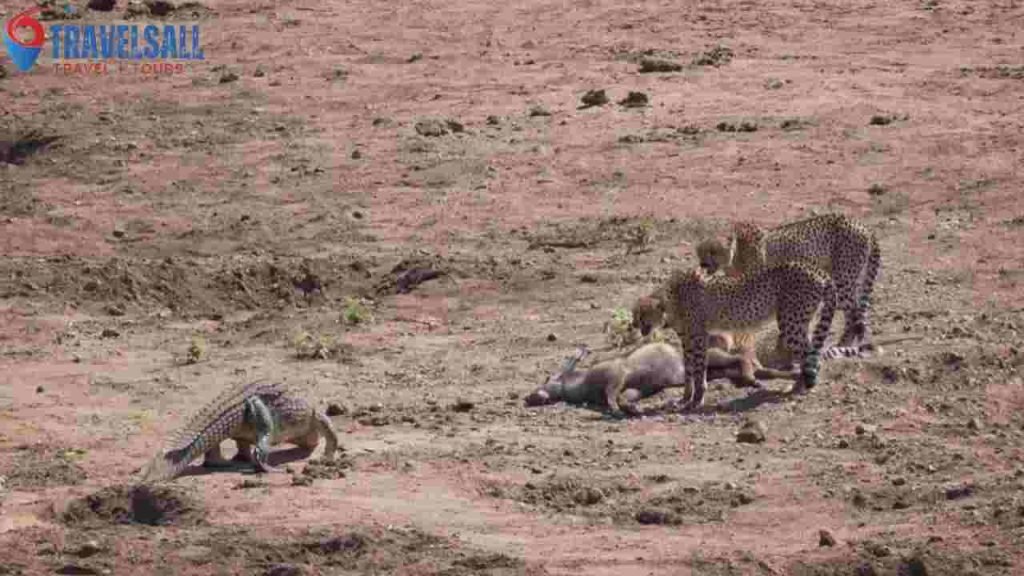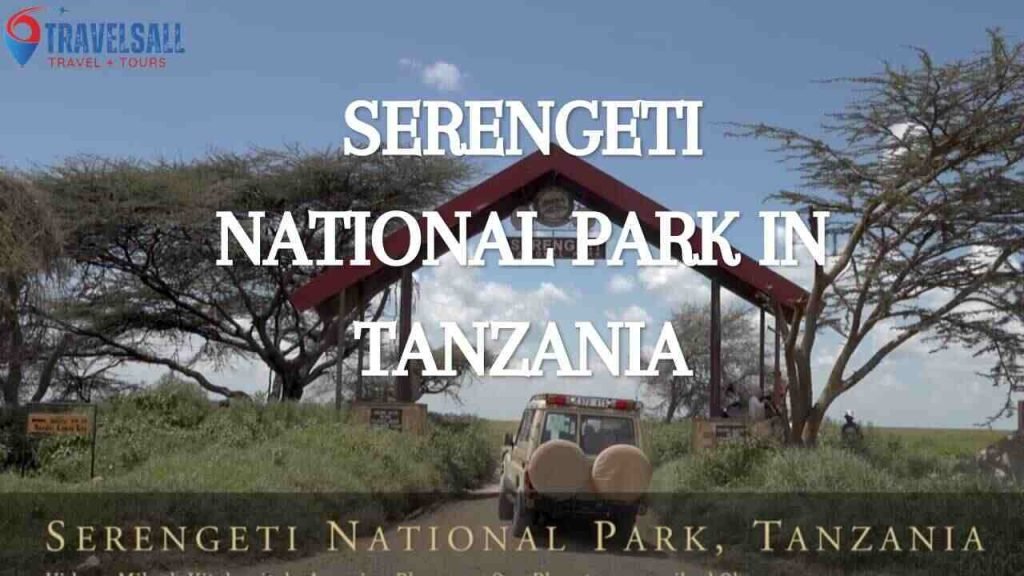If you wondering about Which National Park Has the Most Wildlife? then the answer is Serengeti National Park.
The Serengeti National Park in Tanzania boasts the most abundant wildlife populations. It is renowned for its vast numbers and incredible diversity of species.
Imagine a sprawling savanna, teeming with over two million wildebeest, zebras, and antelopes that move in massive herds across the landscape.
This majestic park serves as the stage for the Great Migration, one of the planet’s most breathtaking natural events.
Every corner of this iconic park is alive with the daily dramas of predator and prey. Elephants, lions, leopards, cheetahs, giraffes, and countless bird species coexist in this dynamic ecosystem.
Serengeti is not just a national park; it’s a symbol of wilderness and a natural wonder that captures the essence of African wildlife.
Global visitors flock to witness this natural spectacle, a must-see for wildlife enthusiasts and photographers.
Table of Contents
ToggleIntroduction To Wildlife Abundance In National Parks

National parks create a sanctuary for countless creatures. They offer a glimpse into the rich diversity of life that thrives in areas protected from the bustling outside world.
From towering forests and sprawling savannas to the jagged peaks of remote mountains. These areas boast some of the world’s most awe-inspiring wildlife gatherings.
Purpose Of National Parks For Wildlife
- Conservation: Safeguard habitats and ensure species survival.
- Education: Teach visitors about natural ecosystems.
- Research: Support studies on environmental and wildlife sciences.
- Recreation: Offer people a chance to witness wildlife in its natural setting.
Criteria For Measuring Wildlife Abundance
Assessing the wildlife abundance in national parks involves various factors:
- Species Count: Tally of different animals present in the park.
- Population Density: Number of animals per unit area.
- Ecological Diversity: Variety of species and ecosystems.
- Species Health: Indicators of well-being and sustainability.
The Contenders For Most Wildlife-rich Park
An exciting quest within the realm of nature is finding which national park boasts the most abundant wildlife. Imagine, from towering elephants to hidden beetles, each park tells a unique story of ecological wealth.
Top National Parks By Continent
Each continent offers a crown jewel of natural splendor:
- Africa: Serengeti National Park – home to the Great Migration.
- Asia: Jim Corbett National Park – a haven for tigers and elephants.
- Europe: Gran Paradiso National Park – where ibex and chamois roam.
- North America: Yellowstone National Park – with its geysers and grizzlies.
- South America: Manú National Park – known for its incredible bird diversity.
- Oceania: Kakadu National Park – rich in aboriginal history and biodiversity.
- Antarctica: No official national parks, but protected areas teem with marine life.
Factors Affecting Biodiversity In National Parks
Understanding why diversity may flourish or falter is key:
| Factor | Influence on Wildlife |
|---|---|
| Climate | Determines habitat types and species survival. |
| Geography | Influences animal migration and plant growth. |
| Conservation Efforts | Enhance or degrade biodiversity through policy. |
| Human Activity | This can lead to habitat loss and species decline. |
| Ecological Interactions | Species relationships shape ecosystem health. |
Yellowstone National Park’s Diverse Ecosystem

Welcome to the remarkable terrain of Yellowstone National Park, a wonderland teeming with a variety of wildlife.
This vast ecosystem stretches over 2.2 million acres of forests, alpine rivers, hot springs, and gushing geysers.
It is home to some of the most fascinating species on the continent. Let’s start on an exploration to discover the inhabitants of this wild and dynamic habitat.
Mammals And Predators Of Yellowstone
Yellowstone provides sanctuary to a vast array of mammals, including iconic species revered by wildlife enthusiasts. Visitors can witness large herds of bison, elegant pronghorns, and elusive mountain lions.
- Bison: The largest land mammal in North America
- Elk: Often spotted in meadows and valleys
- Grizzly Bears: A powerful symbol of the wild
| Animal | Habitat | Conservation Status |
|---|---|---|
| Gray Wolf | Forest and Open Plains | Endangered |
| Cougar | High Elevations, Terrain | Least Concern |
Bird Species And Aquatic Life
The park is also a birder’s paradise, featuring an abundance of bird species across various habitats. Trumpeter swans glide across waters, while peregrine falcons soar through the skies above.
- Bald Eagles: Majestic hunters over Yellowstone’s bodies of water
- American Dipper: Unique aquatic songbirds
Yellowstone’s rivers and lakes are alive with aquatic creatures. Cutthroat trout navigate the cool mountain streams, providing a crucial food source for both terrestrial and avian predators.
- Cutthroat Trout
- River Otters
- Amphibians like the Boreal Chorus Frog
Serengeti’s Great Migration: A Wildlife Phenomenon

The Serengeti’s Great Migration stands as a hallmark of nature’s grandeur. An estimated two million wildebeest grace this Tanzanian landscape, their hooves drumming a testament to survival.
They surge across plains and rivers, trailed by zebras and gazelles, in a timeless quest for green pastures.
This spectacle embodies the circle of life, drawing visitors from across the globe. Predators, from lions to crocodiles, dramatically interact in this life-and-death journey.
The Circle Of Life In The Serengeti
- Calving Season: Over 500,000 calves are born in a synchronized event.
- Wildebeest Trek: A 1,000 km circular journey in search of food and water.
- Predator Encounters: Natural selection on display as predators hunt.
Megafauna And Avian Spectacles
Witness the Serengeti’s megafauna, including elephants, rhinos, and giraffes. Their migrations are less famed but equally critical to the ecosystem’s balance.
The skies too tell a story. Home to over 500 species of birds, the Serengeti is an ornithologist’s paradise.
From the great ostrich to the elusive secretary bird, avian life thrives amid the migratory commotion, each species playing its role in this ecological extravaganza.
India’s Jim Corbett National Park: A Haven For Tigers
Settled in the foothills of the Himalayas lies Jim Corbett National Park, a magnificent sanctuary for wildlife.
It stands as one of India’s most renowned parks, famed for its thriving tiger population. Corbett reveals the majestic Bengal tiger, inspiring awe and admiration for these supreme predators.
Project Tiger And Conservation Success Stories
Jim Corbett National Park shines as a beacon of hope through ‘Project Tiger’. This nationwide conservation initiative began in 1973.
It aimed to safeguard tigers and their habitats. The park boasts a significant increase in tiger numbers, showcasing successful conservation efforts.
These victories are reflected in the thriving biodiversity within its boundaries.
- Tiger population doubling since the project started.
- Revitalization of natural habitats and migration corridors.
- Strict anti-poaching measures enhancing wildlife safety.
Coexistence Of Big Cats And Prey Species
The park’s diverse ecosystem supports a delicate balance, enabling predators and prey to coexist. This harmonious relationship highlights nature’s intricate connections.
Species such as sambar deer, chital, and wild boars thrive under the watchful eyes of prowling leopards and tigers.
Jim Corbett National Park’s unique topography supports various fauna. This includes over 50 mammal species, 580 bird species, and numerous reptiles and fish.
Spotting a majestic tiger during a safari remains a cherished memory for any wildlife enthusiast.
The Kruger National Park: South Africa’s Wildlife Crown Jewel

The Kruger National Park stands as a symbol of South Africa’s rich wildlife heritage.
It spans nearly 20,000 square kilometers.
Endless savannas and deep forests define this land. Here, a tapestry of life unfolds, offering visitors breathtaking encounters with the wild.
The Big Five And The Little Five
The park is renowned for The Big Five: lions, leopards, rhinos, elephants, and buffalos.
These majestic creatures roam freely under the African sun.
Alongside The Big Five, the Little Five intrigues visitors. They are the elephant shrew, buffalo weaver, antlion, rhinoceros beetle, and leopard tortoise.
Both groups represent the park’s diverse ecosystems.
- Lion: King of the Beasts
- Leopard: Elusive tree climber
- Rhino: Armored giant
- Elephant: Gentle giants
- Buffalo: The formidable herdsmen
- Elephant Shrew: Quirky insectivore
- Buffalo Weaver: Sociable nest builder
- Antlion: Ingenious trap maker
- Rhinoceros Beetle: Miniature Hercules
- Leopard Tortoise: Sturdy land dweller
The Park’s Role In Species Preservation
Kruger National Park is not just a sanctuary for the Big and Little Five.
The park plays a vital role in preserving various species.
Through its anti-poaching units and breeding programs, species get protection.
Endangered animals, such as the pangolin and the black rhino, find a haven here.
| Species | Conservation Status | Role of Park |
|---|---|---|
| Black Rhino | Critically Endangered | Breeding & Anti-Poaching |
| Pangolin | Endangered | Research & Habitat Protection |
| Wild Dog | Endangered | Population Monitoring |
The commitment to conservation touches every corner of the park.
This commitment ensures that generations to come will witness these animals in their natural habitat.
Comparative Analysis And Final Thoughts
Exploring which national park boasts the most wildlife
Wonders in the wild beckon as national parks offer rich tapestries of nature’s best. Identifying the top wildlife species in these sanctuaries demands thorough analysis.
Our comparative journey digs into habitats, population dynamics, and conservation status. It determines not just the quantity, but the variety of creatures that call these parks home.
Assessing The National Parks: A Diversity Index
We gauge park biodiversity using a Diversity Index—a tool that measures species richness and abundance.
National parks are prime spots for wildlife viewing; still, each offers distinct features.
We examine these features like we peel layers of an onion, unveiling unique ecosystems and animals that flourish within.
Let’s look closer:
- Species counts highlight parks with the most animals.
- Ecosystem variety indicates multiple habitats.
- Endangered species presence reveals rarity and importance.
Our index results pinpoint parks bustling with life and diversity. With this knowledge, visitors and conservationists alike can better appreciate and support these natural jewels.
Conservation Efforts And The Future Of Wildlife In Parks
Conserving our parks is safeguarding our wildlife’s future. It’s a tether connecting today’s actions to tomorrow’s outcomes.
Discerning how conservation undertakings benefit biodiversity is crucial. This understanding empowers us to make informed decisions for preservation initiatives.
| Park Name | Conservation Status | Known for |
|---|---|---|
| Serengeti National Park | Positive efforts | Great Migration |
| Yellowstone National Park | Recovery programs | Wild bears and wolves |
| Kruger National Park | Anti-poaching success | Big Five animals |
Protective measures shine through active endeavors, such as the revival of species and the curtailing of illegal hunting.
Each park’s future relies on persistent efforts, aligning policies with actions that nurture life in every form.
Your visit supports this mission, combining the joy of witnessing wildlife with the responsibility of conservation.
Frequently Asked Questions Of Which National Park Has The Most Wildlife
Which National Park Has the Highest Number Of Animals?
The Serengeti National Park in Tanzania boasts the highest concentration of wildlife, with millions of animals including the greatest population of large mammals.
Where In The U.S. Has The Most Wildlife?
Alaska boasts the most abundant and diverse wildlife in the United States, home to vast wilderness areas and a plethora of species.
Which National Park Has The Most Diverse Wildlife?
The Yellowstone National Park boasts the most diverse wildlife among national parks, featuring species like bears, wolves, and bison.
What Is The #1 National Park?
The #1 national park varies by country and criteria, but Yellowstone is often cited as the first and one of the most famous globally.
Conclusion
Starting on a wildlife adventure can be transformative, and national parks offer such encounters in abundance.
Our exploration reveals Yellowstone’s unrivaled diversity, making it a top destination for wildlife enthusiasts. So, pack your binoculars and prepare for an unforgettable journey among America’s natural wonders.
Your quest to witness the most wildlife in their natural habitat begins at the gates of Yellowstone.



